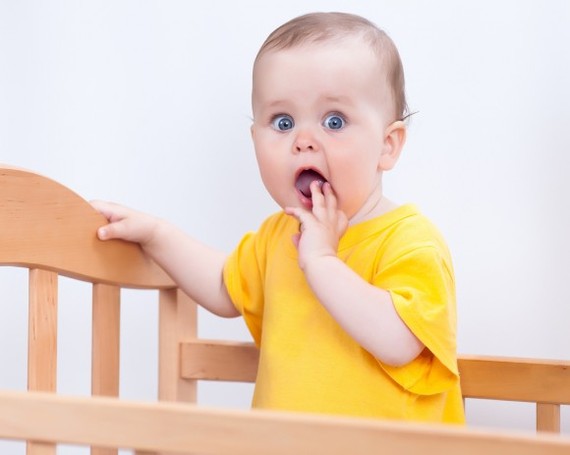I remember the first time I went to a big baby retail store. I saw thousands of products, many I hadn't even known existed, all guaranteed to make my baby happier, sleepier, smarter, healthier, stronger, safer, quieter, cleaner, or prettier. It was my first exposure to the behemoth that is the baby products market, which sees profits in excess of $11 billion per year. (Three children later, I feel I'm personally responsibly for a sizable portion of that profit.)
What's the problem with baby products?
There's another side to the images of shiny, happy babies telegraphed so relentlessly in these stores. It's the fact that some of the products on the shelves contain chemicals that are known or suspected health hazards to babies, and many more contain chemicals that have never been tested for safety. Furthermore, disclosure of chemical ingredients is purely voluntary, so parents have no information to work with.
Part of the problem is a flawed federal chemicals policy, which does not require adequate pre-market safety testing, nor does it require ingredient disclosure. But part of the problem is that these baby retailers are actually selling the stuff.
What's your baby sleeping on?
A new report on baby mattresses highlights the need for retailers to take responsibility for the safety of the products on their shelves.
The report showed that fewer manufacturers are using chemical approaches to meeting infant crib mattress flammability standards compared to a similar report from two years ago. For that, "parents can take heart," said Bobbi Chase Wilding, Deputy Director of Clean and Healthy New York, which authored the report. But the information about the chemicals in the mattresses is not readily available; Bobbi and her team had to do outreach to manufacturers and internet research to compile the information. None of it is available in-store.
Parents are therefore "in the dark about which products are safer and which contain chemicals or materials they might want to avoid," Bobbi said.
Infant crib mattress manufacturers in the U.S. are required to meet flammability standards for their products. Some meet the standard by soaking internal foam with flame retardant chemicals, many of which have been linked to serious health impacts, or using the heavy metal antimony. Others meet the standard by creating a flame barrier just beneath the surface of the mattress, to prevent fire from penetrating the product. Flame retardant chemicals may be sprayed or added to the flame barrier. The most troubling instance of that in the current report is a manufacturer that uses a fiberglass flame barrier with organohalogen flame retardants and the heavy metal antimony.
Are there healthy crib mattress alternatives?
A few manufacturers offer crib mattresses without either flame retardant chemicals or barriers. Pure wool is naturally flame retardant, and is used by some manufacturers as a flame barrier. The best thing a crib manufacturer can do, according to Bobbi, is to design products that are inherently less flammable. Mattresses that have a "low fuel load" are going to burn less quickly and require less chemical or physical fire prevention. These are mattresses that contain something other than foam -- for example, inner spring mattresses.
What can we do to make sure our baby products are safe?
"This report points to the lack of attention companies have paid to the chemicals they are using in their products," Bobbi told me. "We should be asking whether these chemicals should be used in the marketplace."
To that end, Moms Clean Air Force has joined with a group of organizations to tell top baby retailers that it's their responsibility, as stores that cater specifically to pregnant women and babies, to get hazardous chemicals off the shelves. Moms Clean Air Force has signed on to letters to Babies "R" Us and BuyBuyBaby, asking them to take hazardous chemicals off their shelves.
Here's what we wrote to Babies "R" Us:
"We are alarmed that chemicals of high concern are present in children's products, and are found in the bodies of babies and children, in our food supply, in household dust and indoor air, and in the broader environment we all depend on to sustain all life. Although Babies "R" Us has taken a stand on removing BPA and PVC from certain of their product lines, scientists have established links between many other hazardous chemicals and a wide range of chronic diseases and disorders, such as cancer, reduced fertility, learning and developmental disabilities, behavioral problems, obesity, diabetes, and asthma. Therefore, we ask that Babies "R" Us now take additional steps to remove hazardous chemicals from the products you offer for sale.
You have the ability and responsibility as the world's leading children's products provider to work with your suppliers to stop selling products with hazardous chemicals and find truly safer alternatives. Doing so will not only please your customers, it will help you reduce the liability that may be associated with carrying toxic chemicals in your stores."
Sent over a month ago, our coalition has not heard back from either store yet.
What do you expect from the stores you buy your baby products from?
Photo: Shutterstock
